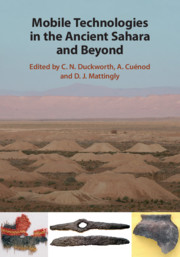Book contents
- Mobile Technologies in the Ancient Sahara and Beyond
- The Trans-Saharan Archaeology Series
- Mobile Technologies in the Ancient Sahara and Beyond
- Copyright page
- Contents
- Figures
- Tables
- Contributors
- Preface
- Part I Introduction
- Part II Technological Mobility and Transfers
- Part III Metallurgy
- 7 Metalworking in Pre-Islamic North Africa
- 8 Is the Archaeometallurgical Record a Valuable Tool when Considering Meroe within a Trans-Saharan Landscape?
- 9 What Is the Meaning of the Extreme Variability of Ancient Ironworking in West Africa?
- Part IV Glass Technology
- Part V Handmade Pottery
- Part VI Conclusion
- Index
- References
8 - Is the Archaeometallurgical Record a Valuable Tool when Considering Meroe within a Trans-Saharan Landscape?
from Part III - Metallurgy
Published online by Cambridge University Press: 18 September 2020
- Mobile Technologies in the Ancient Sahara and Beyond
- The Trans-Saharan Archaeology Series
- Mobile Technologies in the Ancient Sahara and Beyond
- Copyright page
- Contents
- Figures
- Tables
- Contributors
- Preface
- Part I Introduction
- Part II Technological Mobility and Transfers
- Part III Metallurgy
- 7 Metalworking in Pre-Islamic North Africa
- 8 Is the Archaeometallurgical Record a Valuable Tool when Considering Meroe within a Trans-Saharan Landscape?
- 9 What Is the Meaning of the Extreme Variability of Ancient Ironworking in West Africa?
- Part IV Glass Technology
- Part V Handmade Pottery
- Part VI Conclusion
- Index
- References
Summary
At the height of its political power between c.350 BC and AD 350, the Royal City of Meroe was a cosmopolitan trade hub and a melting pot of external influences. In addition to controlling vast regions of land and ruling through the imposition of Kingship sanctioned by a complex religious system, the sovereigns of the Kingdom of Kush built on the economic success of their predecessors by ensuring a flow of trade goods and exotic items through their capital for hundreds of years. Local industry, providing essential objects such as weapons and tools, as well as luxury items, also played a paramount role at Meroe, with external and local influences visible, notably in the ceramics found at the site. Meroitic material culture and the industrial remains provide key insights into the past interconnectedness of the wider region as well as local traditions and innovations. This chapter examines what the Meroitic material culture and iron technology tells us about Meroe’s place and connections within its immediate and more distant landscapes, and how network analysis can help position it in this geographical framework.
- Type
- Chapter
- Information
- Mobile Technologies in the Ancient Sahara and Beyond , pp. 259 - 289Publisher: Cambridge University PressPrint publication year: 2020

